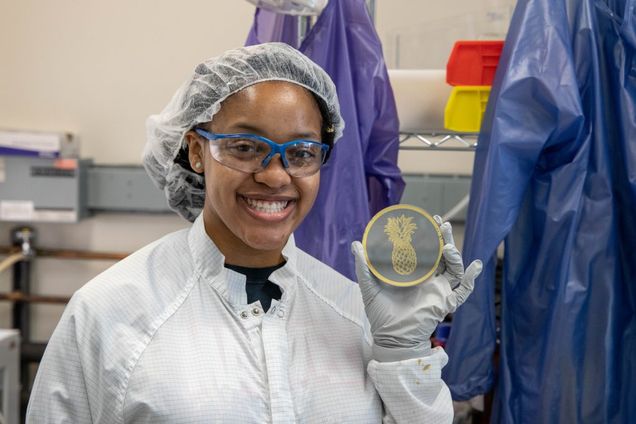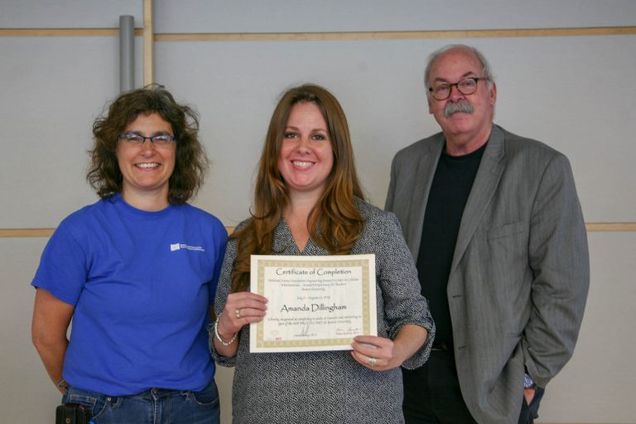Growing Tissue and Engineers
CELL-MET summer programs broaden the pipeline of research engineers
By Patrick L. Kennedy
“Graduate school was never a thought,” says Nicole Bacca. As a teenager applying to Florida International University (FIU), Bacca picked engineering for a major because she couldn’t imagine following four years of college with additional years of law or medical school.
“I thought engineering meant you graduated after four years, got a good salary, and were all set,” says Bacca, who was born in Colombia and raised in Florida. “I had always associated it with industry—I didn’t know there was this whole research component of engineering, that people got their PhD in it.”
But then, after Bacca had enrolled at FIU, Helen Fawcett visited the campus. Fawcett is a research assistant professor of mechanical engineering at the Boston University College of Engineering and the director of student engagement for the NSF Engineering Research Center in Cellular Metamaterials (CELL-MET).

Fawcett told Bacca and other students about CELL-MET’s mission. (FIU and the University of Michigan are partner institutions in CELL-MET, which is led by BU.) Launched in 2017 with funding from the National Science Foundation, CELL-MET is developing a kind of living bandage for the heart. CELL-MET envisions a cardiac tissue patch that would be made from the patient’s own cell samples and implanted to repair an organ damaged by a heart attack.
That mission spoke to Bacca, whose mother was dealing with cardiac issues at the time. So, Bacca applied to CELL-MET’s Research Experience and Mentoring (REM) program, a summer research experience that was designed to identify and mentor FIU undergraduates and expose them to cutting-edge engineering research. It is one of three programs connected to CELL-MET that aim to fill the engineering workforce pipeline by encouraging engineering undergraduates to pursue graduate school or positions in industry, and training high school teachers to nurture STEM interest in their students.
The summer before sophomore year, Bacca helped Professor and Chair of Mechanical Engineering Alice White design, 3D-print, and test scaffolding used to grow cells. Today, she is a PhD student in mechanical engineering at BU. “If I had not done that first REM experience, I would not have pursued grad school,” she says. “That is 100 percent certain.”
Bacca is not alone. Dozens of students from all over the country have taken part in summer research experiences in CELL-MET labs and been inspired to pursue engineering research in academia. For example, Bacca’s FIU classmate Elisa Bravo, another REM participant, spent that same summer in the lab of Professor Kamil Ekinci (ME, MSE), manipulating fluids to learn about boundary conditions for the vasculature of a cardiac patch.
“That definitely changed my whole career path,” says Bravo, who is now a PhD student in mechanical engineering at Michigan. “The REM program is great because you get to experience something new that you might not have considered, and you get some experience under your belt.”
That’s the point, says Cara Ellis McCarthy, CELL-MET administrative director. Along with creating the heart patch, CELL-MET’s mission includes developing a diverse engineering workforce. “The summer programs,” she says, “bring together all those priorities.”
An easy fit
The REM is nearly identical and was integrated into the existing NSF Research Experiences for Undergraduates (REU) Site in Integrated Nanomanufacturing, led by Professor Xin Zhang (ME, ECE, BME, MSE) and Fawcett. Student participants hail from a range of minority-serving institutions, community colleges, and universities that often lack undergraduate research opportunities or graduate programs in engineering. It has existed at the BU Photonics Center, which administers CELL-MET, since 2015. Because that apparatus was already in place, Fawcett was able to launch the summer research experiences for CELL-MET with relative ease in 2018.
In both programs, students receive housing, a stipend, and travel expenses, and spend 10 weeks learning and applying nanofabrication techniques and conducting research in state-of-the-art facilities. They also attend technical and professional development seminars, and take part in social outings.

For most of the students, this is their first time in a lab. “It’s a very newbie-friendly way to get into tissue engineering,” says Francisco Sanchez, who, as an undergrad at the University of Puerto Rico–Mayaguez, spent one REU summer at UM and one at BU (CELL-MET labs are sited at BU as well as its partner institutions, UM and FIU.) “Most of the REUs who go into CELL-MET haven’t had research experience, and they’re usually first-generation college students.”
At UM, Sanchez worked with Professor Stephen Forrest, who recommended Francisco for another summer. The following summer Sanchez worked at BU in the lab of Professor Thomas Bifano (ME, MSE, BME, ECE), director of the Photonics Center. Sanchez designed a setup to measure the effects of mechanical stimulation on heart tissue.
He is now a PhD student in Bifano’s lab. “My decision to go to grad school was based on my experience working in CELL-MET labs,” says Sanchez, who was also drawn to CELL-MET by its mission. In his native Puerto Rico, Sanchez said, “A lot of people suffer from heart conditions, my family included. So, I do see it as a good end goal. People have to do this work.”

Noelle Pierce, came to Boston the summer after sophomore year at Norfolk State University in Virginia to eliminate engineering as a career path. “There were a whole bunch of things I was interested in as a kid,” she says. “I really wanted to rule out engineering at this point, when I’d already done two years of a bachelor’s in chemistry.”
Pierce came to BU as part of the NSF REU Site in Integrated Nanomanufacturing and ended up working on biosensors in the lab of Professor David Bishop (ECE, Physics, MSE, ME, BME), director of CELL-MET.
“In our first conversation, Dr. Bishop said, ‘I’m gonna make an engineer out of you.’ I was like, ‘Ha-ha, little do you know, I’m gonna be working in chemistry.’”
Instead, says Pierce, “the REU changed the trajectory of my career. I realized, ‘Wow, this is what I want to do.’ It really motivated me to get through the rest of college.” Today, Pierce is an MSE PhD student in Bishop’s lab.
Whether REM or REU, mentoring from grad students and faculty is critical to the experience. “Professor Alice White was always there,” says Bacca. “I never felt like I was struggling. I had great mentors, and great female mentors, which in engineering can be difficult to find.”
Teaching teachers about Engineering
The third component of CELL-MET’s workforce development effort is the Research Experience for Teachers (RET) program, in which high school science teachers engage in cutting-edge research and bring that experience back to the classroom. As with the REU programming, BU had an existing NSF RET in Integrated Nanomanufacturing. Leveraging and integrating the ERC RET into the existing RET site helped foster a community rather than siloed teacher experiences.

Amanda Dillingham, science director at East Boston High School, has come to BU for several RETs over the years. Among other things, she has researched vascular density and grown capillaries in the lab of Professor Christopher Chen (BME, MSE), deputy director of CELL-MET.
“It totally transformed my teaching—I rewrote an entire curriculum because of it,” she says. “I integrated engineering into a biology class. Having that lab experience is extremely important in science teaching, and not every teacher has it,” added Dillingham, who recruited several other teachers to take part in the program.
The REM and REU undergraduates are involved, too, effectively teaching the teachers. The students are a few weeks into their research program when the teachers arrive.
“It’s amazing to see the students’ growth,” says Fawcett of the students. “On day one, they’re completely overwhelmed and maybe don’t have confidence in their abilities. And four weeks later, they understand what they’re doing and they’re able to give a presentation about their research to the teachers.”
The outreach doesn’t end there. Some REU students and current CELL-MET graduate students, under Fawcett’s guidance, give biomedical engineering presentations, help train high school students to teach those same concepts to younger kids, and are on hand to assist in the classroom visits.
Fawcett’s outreach in high schools continues to bear fruit. One young woman who worked with Fawcett is now in college, majoring in biomedical engineering. She is coming to BU this summer to conduct research in Ekinci’s lab, thanks to supplemental funding from the NSF.